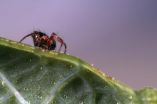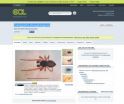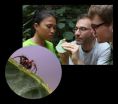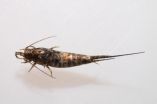(Press-News.org) Researchers and the public can now have immediate access to data underlying discovery of new species of life on Earth, under a new streamlined system linking taxonomic research with open data publication.
The partnership paves the way for unlocking and preserving a wealth of 'small data' backing up research conclusions, which often become lost within a few years of an article's publication in an academic journal.
In the first example of the new collaboration in action, the Biodiversity Data Journal carries a peer-reviewed description of a new species of spider discovered during a field course in Borneo just one month ago. At the same time, the data showing location of the spider's occurrence in nature are automatically harvested by the Global Biodiversity Information Facility (GBIF), and richer data such as images and the species description are exported to the Encyclopedia of Life (EOL).
This contrasts with an average 'shelf life' of twenty-one years between field discovery of a new species and its formal description and naming, according to a recent study in Current Biology.
A group of scientists and students discovered the new species of spider during a field course in Borneo, supervised by Jeremy Miller and Menno Schilthuizen from the Naturalis Biodiversity Center, based in Leiden, the Netherlands. The species was described and submitted online from the field to the Biodiversity Data Journal through a satellite internet connection, along with the underlying data . The manuscript was peer-reviewed and published within two weeks of submission. On the day of publication, GBIF and EOL have harvested and included the data in their respective platforms.
The new workflow established between GBIF, EOL and Pensoft Publishers' Biodiversity Data Journal, with the support of the Swiss NGO Plazi, automatically exports treatment and occurrence data into a Darwin Core Archive, a standard format used by GBIF and other networks to share data from many different sources. This means GBIF can extract these data on the day of the article's publication, making them immediately available to science and the public through its portal and web services, further enriching the biodiversity data already freely accessible through the GBIF network. Similarly, the information and multimedia resources become accessible via EOL's species pages.
One of the main purposes of the partnership is to ensure that such data remain accessible for future use in research. A recent study published in Current Biology found that 80 % of scientific data are lost in less than 10 years following their creation.
Donald Hobern, GBIF's Executive Secretary, commented: "A great volume of extremely important information about the world's species is effectively inaccessible, scattered across thousands of small datasets carefully curated by taxonomic researchers. I find it very exciting that this new workflow will help preserve these 'small data' and make them immediately available for re-use through our networks."
"Re-use of data published on paper or in PDF format is a huge challenge in all branches of science", said Prof. Lyubomir Penev, managing director of Pensoft and founder of the Biodiversity Data Journal. "This problem has been tackled firstly by our partners from Plazi who created a workflow to extract data from legacy literature and submit it to GBIF. The workflow currently launched by GBIF, EOL and the Biodiversity Data Journal radically shortens the way from publication of data to their sharing and re-use and makes the whole process cost efficient", added Prof. Penev.
The elaboration of the workflow from BDJ and Plazi to GBIF through Darwin Core Archive was supported by the EU-funded project EU BON (Building the European Biodiversity Observation Network, grant No 308454). The basic concept has been initially discussed and outlined in the course of the pro-iBiosphere project (Coordination and policy development in preparation for a European Open Biodiversity Knowledge Management System, addressing Acquisition, Curation, Synthesis, Interoperability and Dissemination, grant No 312848).
INFORMATION:
Additional information:
The Global Biodiversity Information Facility (GBIF) is an international open data infrastructure, funded by governments. It allows anyone, anywhere to access data about all types of life on Earth, shared across national boundaries via the Internet. By encouraging and helping institutions to publish data according to common standards, GBIF enables research not possible before, and informs better decisions to conserve and sustainably use the biological resources of the planet.
The Encyclopedia of Life (EOL) operates as an ongoing collaboration among its international partners with the mission to raise awareness and understanding of living nature. With additional support from a global network of content partners, curators and users, EOL works to provide free, open, multilingual, digital access to trusted information on all known species.
Pensoft Publishers specialize in academic and professional book and journal publishing, mostly in the field of biodiversity science and natural history. On 16th of September 2013, Pensoft launched the Biodiversity Data Journal (BDJ) and the associated Pensoft Writing Tool (PWT), as the first workflow ever to put together article authoring, community peer-review, publishing and dissemination within a single online collaborative platform.
Plazi GmbH is a service SME owned by the Swiss based not for profit Plazi Verein, supporting and promoting the development of persistent and openly accessible digital taxonomic literature. Plazi GmbH has been founded to provide services, training and consulting in the domain of digitization, open access publishing and access to taxonomy related published content.
Original source:
Miller J, Schilthuizen M, Burmester J, van der Graaf L, Merckx V, Jocqué M, Kessler P, Fayle T, Breeschoten T, Broeren R, Bouman R, Chua W, Feijen F, Fermont T, Groen K, Groen M, Kil N, de Laat H, Moerland M, Moncoquet C, Panjang E, Philip A, Roca-Eriksen R, Rooduijn B, van Santen M, Swakman V, Evans M, Evans L, Love K, Joscelyne S, Tober A, Wilson H, Ambu L, Goossens B (2014) Dispatch from the field: ecology of micro web-building spiders with description of a new species. Biodiversity Data Journal 2: e1076. DOI: 10.3897/BDJ.2.e1076
Contacts:
Tim Hirsch
Global Biodiversity Information Facility (GBIF)
Email: thirsch@gbif.org
Tel.: +45 28751485
Jeremy Miller
Naturalis Biodiversity Center
Email: jeremy.miller@naturalis.nl
Lyubomir Penev
Pensoft Publishers
Email: penev@pensoft.net
Despatch from the field
New species discovery, description and data sharing in less than 30 days
2014-03-27
ELSE PRESS RELEASES FROM THIS DATE:
Acupuncture enhances antidepressant effect of Seroxat
2014-03-27
Acupuncture is more effective than oral antidepressants in improving depressive symptoms, and produces fewer side effects than tricyclic antidepressants. Despite the continued development of antidepressants and alternative/synergistic therapies, major depressive disorder has not been comprehensively recognized and treatment outcome is often insufficient. An epidemiological study addressing depression showed that poor recognition and treatment are largely linked to the lack of an accurate assessment tool and to patients' economic situation. Prof. Yong Huang and team from ...
Hormone levels linked to survival of deer calves, study suggests
2014-03-27
Levels of a key hormone in the blood may be important for the survival prospects of newborn animals, a study of wild deer suggests.
First-born male deer that have relatively high levels of the male hormone testosterone are less likely to survive their first year compared with their peers, the research shows.
Scientists say their findings suggest that high testosterone levels represent a risk to newborns which, when coupled with a new mother's inexperience, lowers their chances of survival.
High levels of testosterone in adult male animals, including deer, are known ...
Ultra-thin light detectors
2014-03-27
This news release is available in German. Subtle interactions of electrons and light make them so valuable for technology: ultra-thin systems of semiconductor layers can turn electrical voltage into light. But they can also be used the other way around and serve as light detectors. Until now, it has been hard to couple light into these layered semiconductor systems. Scientists at Vienna University of Technology solved this problem. They used metamaterials, which are able to manipulate light in the terahertz range due to their special microscopic structure.
Customized ...
Simple blood test may predict if a child will become obese
2014-03-27
Researchers at the Universities of Southampton, Plymouth and Exeter used the test to assess the levels of epigenetic switches in the PGC1a gene – a gene that regulates fat storage in the body.
Epigenetic switches take place through a chemical change called DNA methylation, which controls how genes work and is set during early life.
The Southampton team found that the test, when carried out on children at five years old, differentiates between children with a high body fat and those with a low body fat when they were older. Results showed that a rise in DNA methylation ...
Predicting oil changes in industrial applications without interrupting operations
2014-03-27
This news release is available in German.
Predictive maintenance of hard-to-access plants, no unnecessary oil changes, no unnecessary laboratory costs and less environmental impact. These are just some of the benefits offered by a new system that can monitor the condition of lubricating oils, hydraulic oils and other fluids in industrial installations without interrupting ongoing operations. The method was developed by engineers from Saarbrücken in collaboration with project partners. The compact sensor system is available as a portable unit or can be built into ...
Democratizing data visualization
2014-03-27
In 2007, members of the Haystack Group in MIT's Computer Science and Artificial Intelligence Laboratory released a set of Web development tools called "Exhibit." Exhibit lets novices quickly put together interactive data visualizations, such as maps with sortable data embedded in them; sortable tables that automatically pull in updated data from other sites; and sortable displays of linked thumbnail images.
In April, at the Association for Computing Machinery's Conference on Human Factors in Computing Systems, Haystack members will present an in-depth study of the ways ...
Students on field course bag new spider species
2014-03-27
As a spin-off (pun intended) of their Tropical Biodiversity course in Malaysian Borneo, a team of biology students discover a new spider species, build a makeshift taxonomy lab, write a joint publication and send it off to a major taxonomic journal.
Discovering a new spider species was not what she had anticipated when she signed up for her field course in Tropical Biodiversity, says Elisa Panjang, a Malaysian master's student from Universiti Malaysia Sabah. She is one of twenty students following the course, organised by Naturalis Biodiversity Center in The Netherlands, ...
The first insects were not yet able to smell well
2014-03-27
This news release is available in German. An insect's sense of smell is vital to its survival. Only if it can trace even tiny amounts of odor molecules is it is able to find food sources, communicate with conspecifics, or avoid enemies. According to scientists at the Max Planck Institute for Chemical Ecology in Jena, Germany, many proteins involved in the highly sensitive odor perception of insects emerged rather late in the evolutionary process. The very complex olfactory system of modern insects is therefore not an adaptation to a terrestrial environment when ancient ...
One gene, many tissues
2014-03-27
Genes are the "code" for building the biological elements that form an organism. The DNA that makes up genes contains the instructions to synthesise proteins, but it's wrong to think that, for a given gene, these instructions are always the same for all parts of the organisms. In actual fact, the gene varies depending on the tissue where it is located (cerebral cortex, cerebellum, olfactory epithelium, etc.); in particular, what varies is the point in the "string" of code at which protein synthesis starts. This complexity complicates the work of scientists considerably, ...
How size splits cells
2014-03-27
One of the scientists who revealed how plants "do maths" can now reveal how cells take measurements of size. Size is important to cells as it determines when they divide.
In a paper published in eLife, Professor Martin Howard from the John Innes Centre and colleagues from the US, Germany and Singapore discovered that cells measure their surface area using a particular protein, cdr2p. The finding challenges a previous model suggesting that another protein called pom1p senses a cell's length.
"Many cell types have been shown to reach a size threshold before they commit ...
LAST 30 PRESS RELEASES:
Azacitidine–venetoclax combination outperforms standard care in acute myeloid leukemia patients eligible for intensive chemotherapy
Adding epcoritamab to standard second-line therapy improves follicular lymphoma outcomes
New findings support a chemo-free approach for treating Ph+ ALL
Non-covalent btki pirtobrutinib shows promise as frontline therapy for CLL/SLL
University of Cincinnati experts present research at annual hematology event
ASH 2025: Antibody therapy eradicates traces of multiple myeloma in preliminary trial
ASH 2025: AI uncovers how DNA architecture failures trigger blood cancer
ASH 2025: New study shows that patients can safely receive stem cell transplants from mismatched, unrelated donors
Protective regimen allows successful stem cell transplant even without close genetic match between donor and recipient
Continuous and fixed-duration treatments result in similar outcomes for CLL
Measurable residual disease shows strong potential as an early indicator of survival in patients with acute myeloid leukemia
Chemotherapy and radiation are comparable as pre-transplant conditioning for patients with b-acute lymphoblastic leukemia who have no measurable residual disease
Roughly one-third of families with children being treated for leukemia struggle to pay living expenses
Quality improvement project results in increased screening and treatment for iron deficiency in pregnancy
IV iron improves survival, increases hemoglobin in hospitalized patients with iron-deficiency anemia and an acute infection
Black patients with acute myeloid leukemia are younger at diagnosis and experience poorer survival outcomes than White patients
Emergency departments fall short on delivering timely treatment for sickle cell pain
Study shows no clear evidence of harm from hydroxyurea use during pregnancy
Long-term outlook is positive for most after hematopoietic cell transplant for sickle cell disease
Study offers real-world data on commercial implementation of gene therapies for sickle cell disease and beta thalassemia
Early results suggest exa-cel gene therapy works well in children
NTIDE: Disability employment holds steady after data hiatus
Social lives of viruses affect antiviral resistance
Dose of psilocybin, dash of rabies point to treatment for depression
Helping health care providers navigate social, political, and legal barriers to patient care
Barrow Neurological Institute, University of Calgary study urges “major change” to migraine treatment in Emergency Departments
Using smartphones to improve disaster search and rescue
Robust new photocatalyst paves the way for cleaner hydrogen peroxide production and greener chemical manufacturing
Ultrafast material captures toxic PFAS at record speed and capacity
Plant phenolic acids supercharge old antibiotics against multidrug resistant E. coli
[Press-News.org] Despatch from the fieldNew species discovery, description and data sharing in less than 30 days







